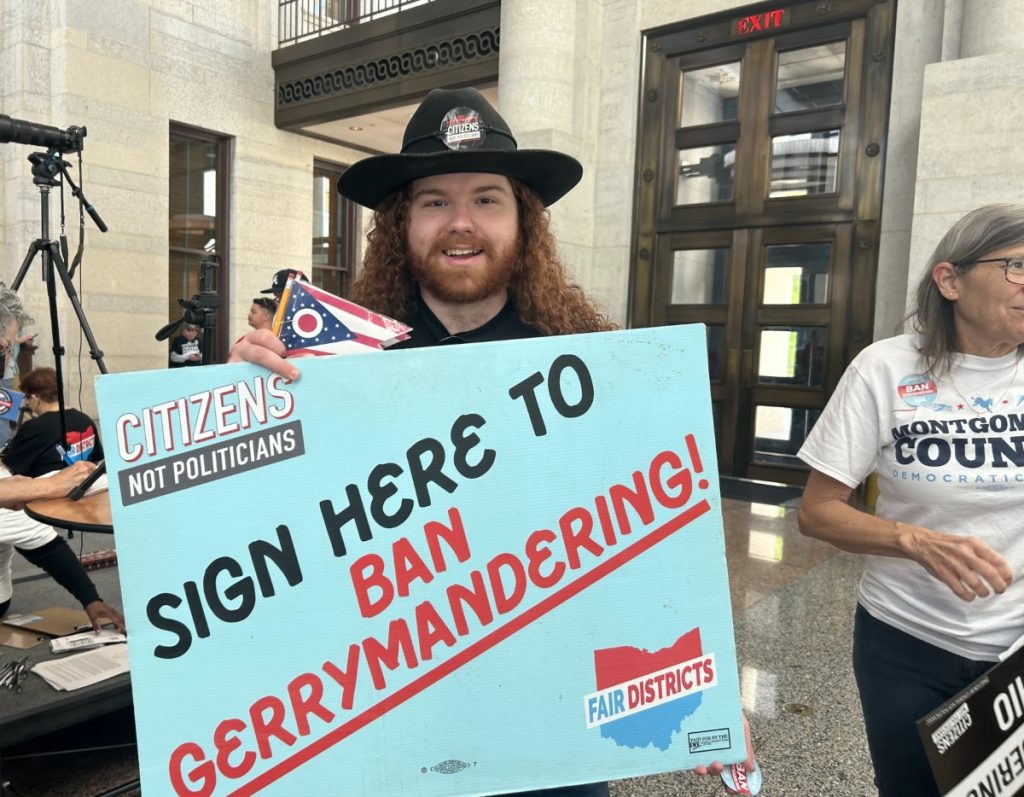COLUMBUS, Ohio (Statehouse News Bureau) — Gov. Mike DeWine has come out against the proposal on the fall ballot to change the way lawmakers’ district lines are drawn. He also touted Iowa’s redistricting process as one that should be used in the Buckeye State.
But backers of Citizens Not Politicians, the group supporting Ohio’s proposed amendment, said elements of that process in Iowa were included in the Ohio proposal.
While announcing his opposition to the redistricting amendment on the November ballot, DeWine asked voters to reject the Citizens Not Politicians amendment. That proposal would replace the seven members of the Ohio Redistricting Commission, who are all elected officials, with a 15-member panel composed equally of Republicans, Democrats and independents, selected by judges in a detailed process. Voters passed amendments to allow the Ohio Redistricting Commission to approve maps for legislative and congressional districts in 2015 and 2018.
DeWine promised to work with Republican lawmakers next year to adopt a plan similar to the one used in Iowa.
“I believe the Iowa system provides us with an example of a system that takes politics out of map drawing. Map draws are under the Iowa plan, prohibited. They are prohibited from looking at past voting patterns. The Iowa system is clean. It is simple and has been used successfully to achieve the good government objectives that we all associate with true reform,” DeWine said.
He also warned that if the redistricting issue passes, “it will directly result in the worst gerrymandering we have ever seen.”

A closer look at the Iowa plan
Chris Larimer, professor of Political Science at the University of Northern Iowa, said that state’s redistricting system was first developed in the 1980’s because the previous method resulted in political fights over boundary lines. One of the key features is that partisan data can’t be considered when drawing districts.
Larimer said the process includes a nonpartisan legislative agency that draws maps largely based on population numbers, with an emphasis on compactness – keeping communities together as much as possible. And sometimes, he said, it causes a problem for some politicians.
“You know what happens every redistricting cycle is you get down to those state legislative districts, you have incumbents drawn into the same districts, sometimes incumbents of the same party, and they end up having to run against each other in a primary or they decide to move to another district,” Larimer said.
And Larimer explained that Iowa lawmakers still have the final say because they have to approve the maps or draw their own within certain parameters. But if they can’t agree on maps by Sept. 15, the Iowa Supreme Court creates them.
Redistricting experts weigh in
Independent groups that do research in redistricting widely regard Ohio’s current congressional and legislative maps as some of the most gerrymandered in the nation. Sam Wang is a redistricting expert with the non-partisan Princeton Gerrymandering Project.
He’s looked into whether he thought any plan like Iowa’s that involved the legislature could work in Ohio, where Republicans have a supermajority in both chambers of the state legislature, control all elected statewide offices, and the majority of the seats on the Ohio Supreme Court.
“The temptation is overwhelming to self-deal. And it’s just really hard for any human, including a politician, to overcome that temptation,” Wang said.
“The Ohio plan that’s on the ballot this November comes the closest to being a silver bullet to getting to fair districting,” Wang said.
Simone Leeper is legal counsel on the redistricting team at the Campaign Legal Center, a non-partisan government watchdog group founded by Trevor Potter, former Republican chairman of the Federal Election Commission. Leeper’s group recently conducted a study and determined three factors that produce effective maps. She said the first thing is to remove politicians from the map-drawing process.
“So partisan politicians should not have a role in redistricting in order to ensure the best outcomes. You also will want a commission that has the full authority of redistricting, meaning that it is not an advisory commission where it makes a recommendation to a legislative body that can be ignored or overruled, and you will want to make sure there is a full transparent process where there are sufficient opportunities for public input.”
Leeper says the ballot measure before Ohio voters this November accomplishes those key goals and “it truly hits the mark as the gold standard for a redistricting commission.”
Citizens Not Politicians says amendment came from research
Chris Davey, a spokesman for Citizens Not Politicians, said the writers of the amendment did their homework and researched the existing redistricting plans, including Iowa’s.
“We systematically looked at all of the states that have successfully used a citizens commission model. And what we did was look at the best of what they had and what worked and took the stuff that didn’t work and left it aside and what we have developed here is something new,” Davey said. “It is developed by Ohioans for Ohio and we really think that this is going to become the national gold standard for how to do redistricting.”
Davey said the Iowa plan doesn’t work for one reason – it still keeps politicians in the process. He said his group’s plan would cut politicians out of the map-drawing process altogether. He noted one Democrat and one Republican who served on the redistricting commission that came up with the current maps are running unopposed in November.

